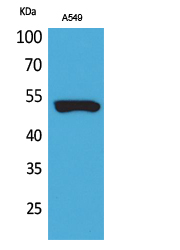Total Cytokeratin 8 Cell-Based Colorimetric ELISA Kit
- Catalog No.:KA3138C
- Applications:ELISA
- Reactivity:Human;Mouse;Rat
- Gene Name:
- KRT8
- Human Gene Id:
- 3856
- Human Swiss Prot No:
- P05787
- Mouse Swiss Prot No:
- P11679
- Rat Swiss Prot No:
- Q10758
- Storage Stability:
- 2-8°C/6 months
- Other Name:
- Keratin, type II cytoskeletal 8 (Cytokeratin-8) (CK-8) (Keratin-8) (K8) (Type-II keratin Kb8)
- Detection Method:
- Colorimetric
- Background:
- disease:Defects in KRT8 are a cause of cryptogenic cirrhosis [MIM:215600].,function:Together with KRT19, helps to link the contractile apparatus to dystrophin at the costameres of striated muscle.,miscellaneous:There are two types of cytoskeletal and microfibrillar keratin: I (acidic; 40-55 kDa) and II (neutral to basic; 56-70 kDa).,PTM:O-glycosylated at multiple sites; glycans consist of single N-acetylglucosamine residues.,PTM:Phosphorylation on serine residues is enhanced during EGF stimulation and mitosis. Ser-74 phosphorylation plays an important role in keratin filament reorganization.,similarity:Belongs to the intermediate filament family.,subunit:Heterotetramer of two type I and two type II keratins. keratin-8 associates with keratin-18. Associates with KRT20. Interacts with HCV core protein and PNN. When associated with KRT19, interacts with DMD. Interacts with TCHP.,tissue specificity:Observed in muscle fibers accumulating in the costameres of myoplasm at the sarcolemma membrane in structures that contain dystrophin and spectrin. Expressed in gingival mucosa and hard palate of the oral cavity.,
- Function:
- apoptosis, cytoskeleton organization, cell death, programmed cell death, death, cytokine-mediated signaling pathway,tumor necrosis factor-mediated signaling pathway,
- Subcellular Location:
- Cytoplasm . Nucleus, nucleoplasm . Nucleus matrix .
- Expression:
- Observed in muscle fibers accumulating in the costameres of myoplasm at the sarcolemma membrane in structures that contain dystrophin and spectrin. Expressed in gingival mucosa and hard palate of the oral cavity.
- June 19-2018
- WESTERN IMMUNOBLOTTING PROTOCOL
- June 19-2018
- IMMUNOHISTOCHEMISTRY-PARAFFIN PROTOCOL
- June 19-2018
- IMMUNOFLUORESCENCE PROTOCOL
- September 08-2020
- FLOW-CYTOMEYRT-PROTOCOL
- May 20-2022
- Cell-Based ELISA│解您多样本WB检测之困扰
- July 13-2018
- CELL-BASED-ELISA-PROTOCOL-FOR-ACETYL-PROTEIN
- July 13-2018
- CELL-BASED-ELISA-PROTOCOL-FOR-PHOSPHO-PROTEIN
- July 13-2018
- Antibody-FAQs


